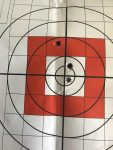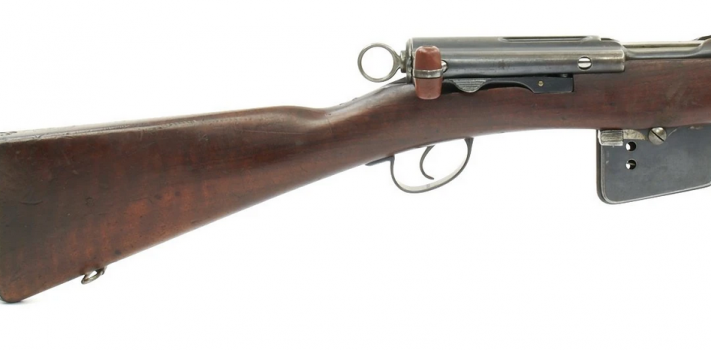I would like to share with you my experience with the Schmidt Rubin Model 1889 rifle. Antique because of its pre-1899 status, it can legally be shipped directly to the buyer in most states, if the seller properly understands the law. I’m sure you’re aware some will not ship without FFL regardless of antique status.
Your exhortations to buy antique firearms have not gone unheeded. Prices have indeed gone out of sight. These rifles are now in the six or seven hundred dollar range, or more.
I am not a gunsmith nor an expert on firearms, antique or otherwise. My Grandfather and the U. S. Army are the primary source of my firearms training. I am a machinist by trade. My experience with these rifles is limited to the two examples given and what I have learned on the internet and from other enthusiasts.
Best I can determine, these rifles came in a barrel length of 31” and 23.3”. The two rifles pictured have been referred to as “sporterized”, I don’t believe this is the case in the usual “Bubba” sense. I’ve also read them referred to as “sporters”, and I believe they were either produced at the factory or some other party modified them. They are identical in all respects.
The Swiss are second to none in quality of workmanship. The wood-to-metal fit of these rifles is extraordinary. The straight pull action was high-tech, for its day. The bolt is very simple, perhaps simpler than the Mosin. Operating the bolt makes a sound similar to a pump shotgun. The ring at the rear of the bolt may look funny, but it is very functional. The trigger pull has a long take up, but the release itself is remarkably crisp and light. The magazine capacity is 12 rounds, quite generous for the day, and is removable, which takes some effort as it fits very closely. I doubt it was ever intended to be quick-change in the AR or AK sense. There is a magazine cut off which lowers the magazine preventing the next round from being picked up and allowing for single round loading but in 1908 it was decided this feature was unnecessary and rendered inoperative with the addition of a small stamping over the operating lever which can be removed if one so desires. The magazine can be charged with two six-round stripper clips.

See Photo 1. This rifle was given to a friend. I had never seen one before. He asked if I could clean it up for him, which I did. In the process I researched from the Internet and local gun enthusiasts who know more than I do about old rifles. I found the ammunition unobtainium, but that it could be handloaded from 7.5×55 Swiss brass. I should have told him it was hopeless and offered him $100, instead I cleaned it up best I could given the rusty condition of the metal and white blotches on the wood and offered him $100. He decided he’d keep it for a wall hanger.

See Photo 2. Now interested in these rifles, I banged around on the web and tripped over a very similar carbine length rifle for a few hundred dollars from a pawn shop out west. The owner shipped it to my door. It was in much better condition and cleaned up nicely. It looks like it was made yesterday rather than 130 years ago.
NOTE: It is not recommended that 7.5×55 rounds be fired in the Model 1889 rifle. Apparently, they will chamber and fire, but are a much hotter round than the 7.5×53.5. There is an anecdotal reference that the Swiss army said this was to be done only in an emergency.
JWR Adds: For those who don’t handload, be advised that early examples of the Swiss Model 1896/11 Schmidt-Rubin represent “the best of both worlds”, since they are pre-1899, yet safe to shoot with the modern high-pressure GP-11 7.5×55 ammunition. To be legally antique under U.S. law, a Model 1896/11 must have a serial number below 236,500. I have difficulty finding enough of these to keep in my Elk Creek Company inventory, as they sell almost immediately after I list them.
Handloading: A friend and I were most fortunate to buy reloading equipment from someone who was getting out of the cowboy action game. For $100 we bought almost everything we need to reload metallic and shotshell cartridges, including a case trimmer and a few sets of dies. The press is a Lyman Spartan which must be fifty years old and still works well. It took a couple weeks of cruisin’ Gunbroker.com but I bought everything I need to handload the 7.5×53.5 cartridge including a collet for the case trimmer, a set of dies and a couple of hundred pieces 7.5×55 brass. I also bought a spare rear sight leaf, more on that later.
The brass must be sized, trimmed to 53.5mm (2.106”) length, and the case mouth deburred. I selected a mild load — derived from Krag loading data — of 180 grain jacketed soft point bullet and 22 grains of IMR 2400 powder for about 1,800 fps.
First shots: Some have reported minor differences at the shoulder between the 7.5×55 and7.5×53.5 and apparently this is true. Chambering required a firm hand forward on the bolt. I fired a few shots into the hill behind the house. This was mostly a function check, fired from standing position, not rested, hit what I was aiming at. Recoil was light. I was pleased with the results, thusfar.
At the 25 yd range: We are most fortunate to have an excellent and well-run gun shop with an indoor range. I keep a yearly membership and try to go shoot when no one else is using the range. At this point, I would like to say the Swiss are not only excellent craftsmen, but they must have the best eyesight in the world, these sights are tiny! At 25 yds grouped about 2”, 8 ½” high and 2 ½” left. I was not surprised by this, some old military rifles are battlesighted for 300+ yds, even the trusty ’03 Springfield, but I hoped the “sporter” model was more in line with civilian shooting.
 Calculating fixed sight adjustment I found the rear sight needed to be lowered 3/16” or the front raised the same. I had bought a spare rear sight leaf and went about modifying it, holding it in a temporary fixture and carefully grinding the top of the sight down and grinding a new notch with the Dremel. This didn’t work as the front of the leaf was now between the rear sight and the front sight. At least I didn’t damage the original sight leaf. I decided to make a new front sight rather than modify the existing one. The front sight is dovetailed. Soaking it overnight in Kroil penetrating oil, it came out easily. I made a new front sight. The base is dovetailed and tapered. I made the blade extra tall on purpose, since it is far easier to remove metal than add metal.
Calculating fixed sight adjustment I found the rear sight needed to be lowered 3/16” or the front raised the same. I had bought a spare rear sight leaf and went about modifying it, holding it in a temporary fixture and carefully grinding the top of the sight down and grinding a new notch with the Dremel. This didn’t work as the front of the leaf was now between the rear sight and the front sight. At least I didn’t damage the original sight leaf. I decided to make a new front sight rather than modify the existing one. The front sight is dovetailed. Soaking it overnight in Kroil penetrating oil, it came out easily. I made a new front sight. The base is dovetailed and tapered. I made the blade extra tall on purpose, since it is far easier to remove metal than add metal.
 Back to the 25 yd indoor range: This did not go well, out of 12 rds 10 keyholed. Not sure why, but the rifling is mirror bright and it passes the bullet test on both ends. This did not happen at the 10 yd familiarization fire, and I may have missed it at the last range session. After consulting the local reloading pro, I’m going try a warmer load of 38 grains of IMR 4895 powder, up around 2100 fps which is similar to the original 1890s load. I was able to determine I was low, which I expected, but no need to make adjustment to the front sight until we get round holes in the target. 25 yd range x3: Success! Got round holes and 2 inch groups, low and left but I expected this. Now I can finish the front sight, verify at the indoor range and head to the 100 yd range on my buddy’s farm to ring some steel. See final target picture, at 25 yard indoor range. I’ll call it good for a 130-year-old rifle and 63-year-old eyes.
Back to the 25 yd indoor range: This did not go well, out of 12 rds 10 keyholed. Not sure why, but the rifling is mirror bright and it passes the bullet test on both ends. This did not happen at the 10 yd familiarization fire, and I may have missed it at the last range session. After consulting the local reloading pro, I’m going try a warmer load of 38 grains of IMR 4895 powder, up around 2100 fps which is similar to the original 1890s load. I was able to determine I was low, which I expected, but no need to make adjustment to the front sight until we get round holes in the target. 25 yd range x3: Success! Got round holes and 2 inch groups, low and left but I expected this. Now I can finish the front sight, verify at the indoor range and head to the 100 yd range on my buddy’s farm to ring some steel. See final target picture, at 25 yard indoor range. I’ll call it good for a 130-year-old rifle and 63-year-old eyes.
I hope this information is helpful to some who may be considering the Schmidt Rubin 1889.










